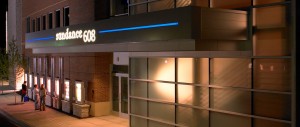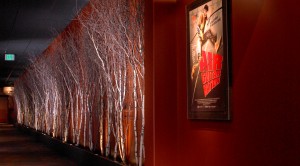 This is part two of a five part series of suggestions for the 2015 Wisconsin Film Festival. If you haven’t done so already, please read at least the first half of part one as a reminder of everything the Wisconsin Film Festival does right and well. With that fresh in mind, I’ll proceed to today’s suggestion. (Sundance 608 photos: Kahler Slater)
This is part two of a five part series of suggestions for the 2015 Wisconsin Film Festival. If you haven’t done so already, please read at least the first half of part one as a reminder of everything the Wisconsin Film Festival does right and well. With that fresh in mind, I’ll proceed to today’s suggestion. (Sundance 608 photos: Kahler Slater)
Suggestion #2: If the Festival likes Sundance, then put a ring on it.
Does the Festival want to be at Sundance, and does Sundance want to be an important home to the Festival? If the answer is yes to both questions, then the Sundance Festival experience should feel like visiting your family for the holidays, not like crashing on a friend’s couch for a few nights too many. I think Madison Film Forum reader Kris Zimmerman put it very succinctly in a comment:
I think the energy associated with having crowds on campus, or downtown, and milling around, wandering into a movie because of buzz, is something that hasn’t been recreated at the Sundance venue. I love it, and am not anti-Sundance either, but it is unfortunate that it seems separate and not fully integrated.
Obviously geography prevents any full integration with the campus components of the Festival. But many Festivals have venues in different parts of their host cities. During my one Sundance Film Festival experience in Park City, Utah, I spent a lot of time on the shuttle between venues. But when I arrived at any venue, I always knew I was at the Sundance Film Festival. I don’t always get that feeling at Sundance 608 during the Wisconsin Film Festival. If the Festival wants me to feel that way, then that feeling has to be created, it won’t just happen by itself by showing certain films on three of Sundance’s screens. Or as Kris suggests, it has to be re-created, because it didn’t just happen by itself downtown, either.
This is not an issue that great programmers can address through their selection of films. And at times I get the sense that Festival programmers couldn’t care less about this issue. This would need to be addressed by a Festival Director. (I’ll elaborate on that point in Suggestion #5 on Friday.)
The Festival doesn’t need to take up all of the Sundance screens, but both partners should be fully committed to each other, and the Festival should be the most important thing going on in the space that week. The Festival needs to figure out its use of the space—and the neighborhood—beyond the logistics of tickets, lines, and crowd control. And Sundance 608 needs to decide if it is a vital community partner in Madison’s most important annual film event, or a corporate chain that simply licenses the name “Sundance” and rents out the space at the right price if it’s not too inconvenient. Personally knowing Sundance 608 manager (and former Orpheum manager) Merijoy Endrizzi-Ray, I’m confident that she would like to answer that with the former, if given the right opportunities (from the Festival and from Sundance offices).

I won’t elaborate on logistics (tickets, lines, and crowd control) here, but I would welcome any thoughts, observations, and suggestions in the comments section from anyone who stood in the long dark Sundance hallway for multiple screenings. Nor will I talk at length about people getting ill in those lines, because one Communication Arts professor, who will likely play a prominent role in the Festival, saw me helping a friend who had a dizzy spell, and he mentioned that he saw other similar cases. (So no need to persuade him about the need to address it.) It’s disappointing to begin your first screening at Sundance with an announcement from a stressed out volunteer apologizing for ticketing glitches and snafus, but I’m confident that the basic logistics can and will be smoother in 2015.
To briefly return to yesterday’s topic of a mission statement, I don’t think the Festival can successfully address what to do at Sundance until it has a clearer idea why it is there, beyond just needing screens. The early Festival was at its venues because of two of its goals: “Promote independent film venues and bring new audiences to these venues,” and “Revitalize the downtown cultural district and independent film scene.” There’s nothing like the second goal going on at Sundance. But can we even say there’s something similar to that first goal going on through the Festival’s time at Sundance, beyond filling seats for one week?
One way to counter the “downtown abandonment” argument is to point out that many of the same people who miss the Festival downtown also vote for Sundance as their favorite Madison movie theater in Isthmus (that can’t be all West Siders voting, right?). Another way is to point out the local people involved at Sundance who are doing good work, rather than treat Sundance like a corporate entity. At one or more screenings, bring out Merrijoy Endrizzi-Ray and thank her so that new audiences can meet the local people who make Sundance 608 happen throughout the year. In other words, do whatever you can to make the Festival experience at Sundance feel like Madison.
More than the downtown location, I think what people really miss is a “hub,” or a home base, for the Festival experience. If the Festival continues to need Sundance (and it will for the foreseeable future) then Sundance either needs to be that hub, or to feel like one. The experience should be less like going through an airport (you don’t really count visiting a city if you’ve only been in its airport) and more like visiting a neighborhood. (Midvale Boulevard is a neighborhood, too, after all.) I’ll elaborate on this a bit more in Thursday’s Suggestion #4.
51 Weeks of Cross-Promotion Might Help
To help solidify the relationship there should be more collaborations between the Festival, campus programmers, and Sundance throughout the year. A good first step has been the occasional sneak preview or special event sponsored by the Cinematheque or WUD Film held at Sundance. But the Wisconsin Film Festival and its programming partners should actively promote Sundance programming by distributing the Sundance Screening Room calendar at the Cinematheque and Union South Marquee (don’t wait for them to ask you, ask them for some copies).
What struck me about seeing a film at Sundance just one week after the Festival was that I could see no evidence that the Festival was ever there. The powerpoint slideshow before the lights go down sells the Sundance brand by showcasing pictures from many important festivals (Sundance, of course, but also Tribeca and others). Am I the only one who thinks it is odd that there are no images showcasing Sundance 608’s vital role in the Wisconsin Film Festival? Couldn’t or shouldn’t there be at least one slide promoting Sundance’s role in the Festival at screenings year round? They do promote their other local events, like Rob Thomas’s post-screening discussions, so this certainly must be a possibility. Has the Festival asked for such a slide? Has Sundance 608 suggested such a slide? The lack of such a simple and obvious cross-promotion suggests that the Festival and Sundance are not yet entirely committed to each other’s success.
If Sundance’s hands are tied and can only produce such a slide as a paid advertisement, then I would suggest a bartered slide exchange at the main Festival venues throughout the year. The powerpoint slide show at the Cinematheque was halted years ago because of a nice curtain, but this would be more important than a nice curtain. The Cinematheque (both 4070 Vilas and the Chazen), the Union South Marquee, and Sundance 608 could produce very simple powerpoint slides promoting each other’s programming. This would also eliminate the long and never effective introductions to screenings where upcoming events are rattled off for several minutes. It is in the interest of each Festival venue to keep people going out to the movies, no matter where they are playing. And maybe Sundance would feel more integrated into the Festival if we had a sense of a Festival partnership at all the venues year round.
You are so correct about Sundance. If Sundance wants the Festival, they have to care about how it is set up and where folks are standing in queue. NOT just how much money the Cafe makes. There is little to no thought from this business about the festival other then staffing a few extra bodies in the cafe and usher posititions.
If the Festival wants to be a Sundance as a venue, please realize there are some pitfalls in scheduling stacked film start times and venue space. It has gotten progressively stressful to be a volunteer at this venue. A Venue showing Three films at a time should be high on the list for organization not last to figure out because it doesn’t start on the first Thursday.
It would behoove both teams to work together to make this venue shine, like I know it can. I use Sundance as my theatre of choice during the rest of the year. I don’t want to learn to avoid it during the Festival.